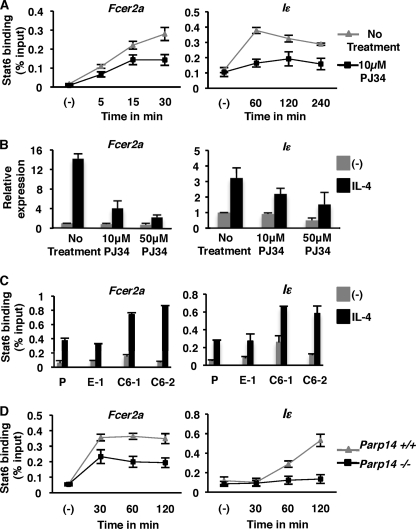FIGURE 1.
PARP-14 and the enzyme activity associated with it dictate the DNA binding ability of Stat6. A, M12 cells were either untreated or pretreated with PJ34 (10 μm) for 30 min, after which IL-4 was added for the indicated times. Nuclear extracts from these cells were then used for ChIP with anti-Stat6 and evaluated for the presence of either the Fcer2a or germline epsilon (Iϵ) promoter by qPCR. B, total RNA was extracted from M12 cells that were treated as indicated. Transcripts for either Fcer2a or Iϵ were quantified using qRT-PCR. The data plotted is the relative expression of Fcer2a normalized to Hprt and compared with untreated samples, relative expression of Iϵ is normalized to Gapdh and compared with untreated controls. C, parental M12 cells (P), two M12 cell lines overexpressing PARP-14 (C6-1 and C6-2) and an empty vector control (E-1) that were generated and published earlier (6) were treated with IL-4 and Stat6 ChIPs were performed similar to A. D, B cells were isolated from either Parp14−/− or wild-type littermate controls and were treated with IL-4 for the indicated time points. ChIP experiments similar to A were performed on nuclear extracts obtained from these cells. The data plotted for each panel is the mean (±S.E.) of three independent experiments.

